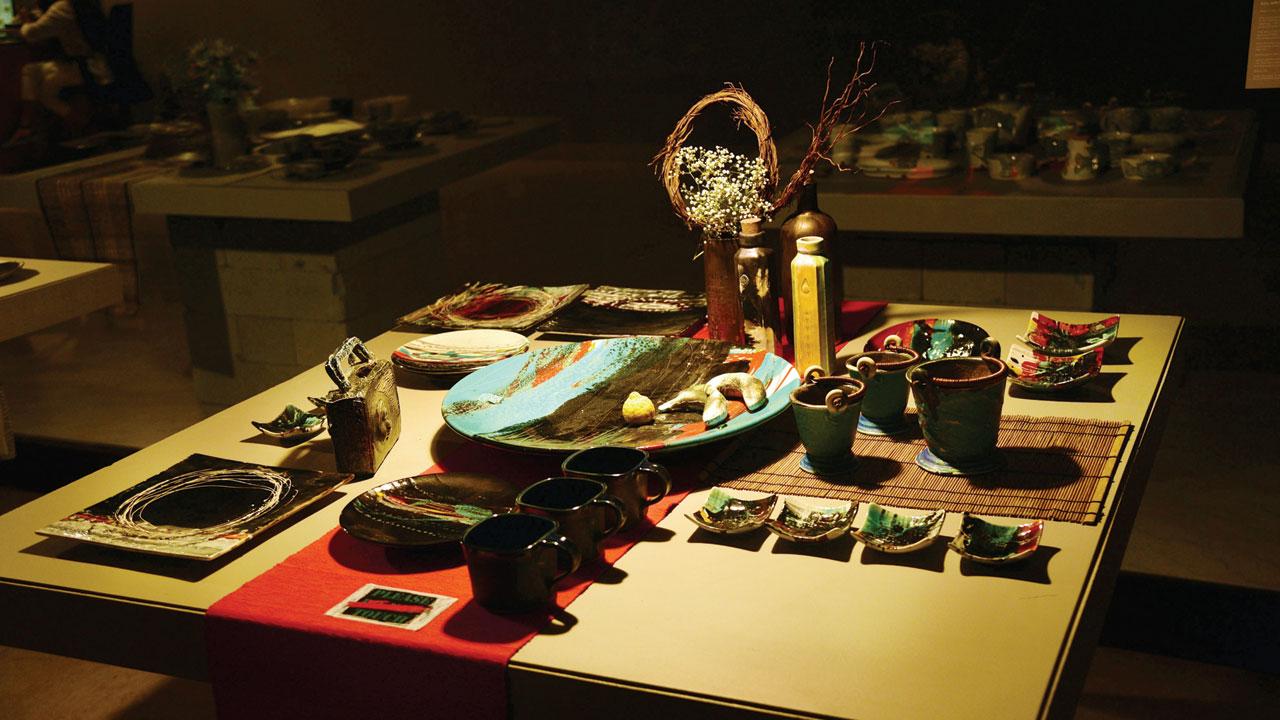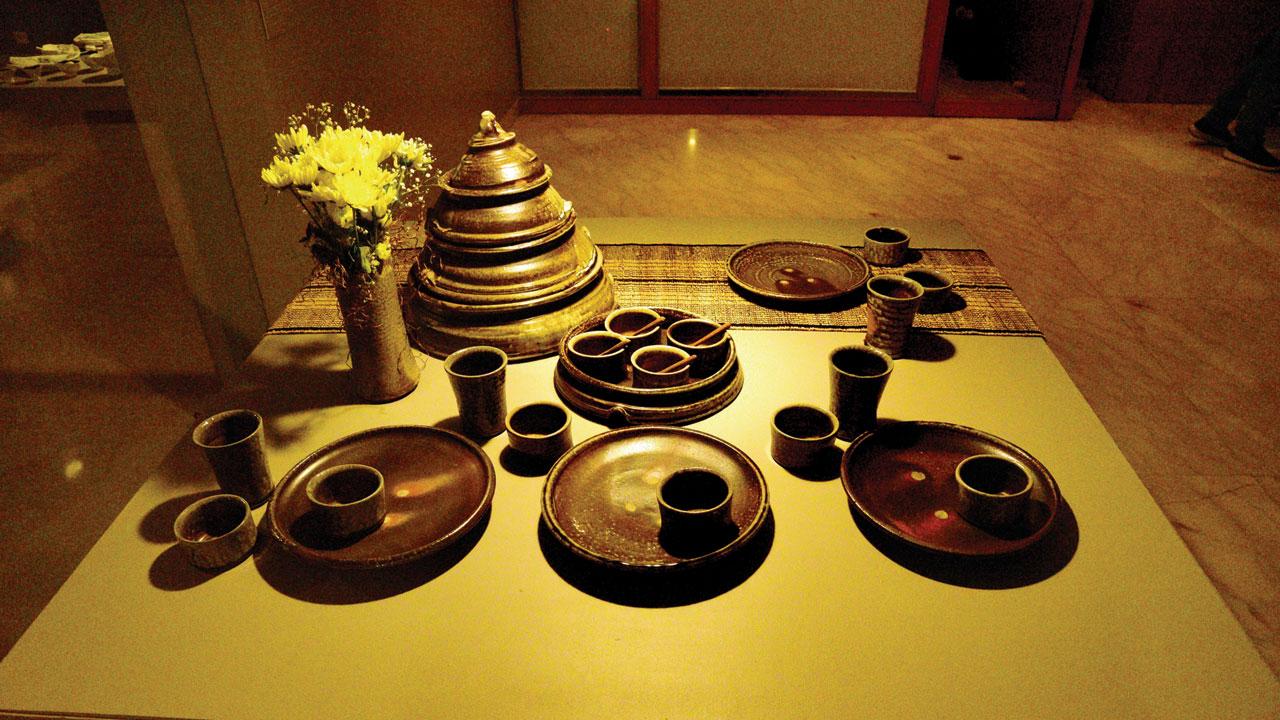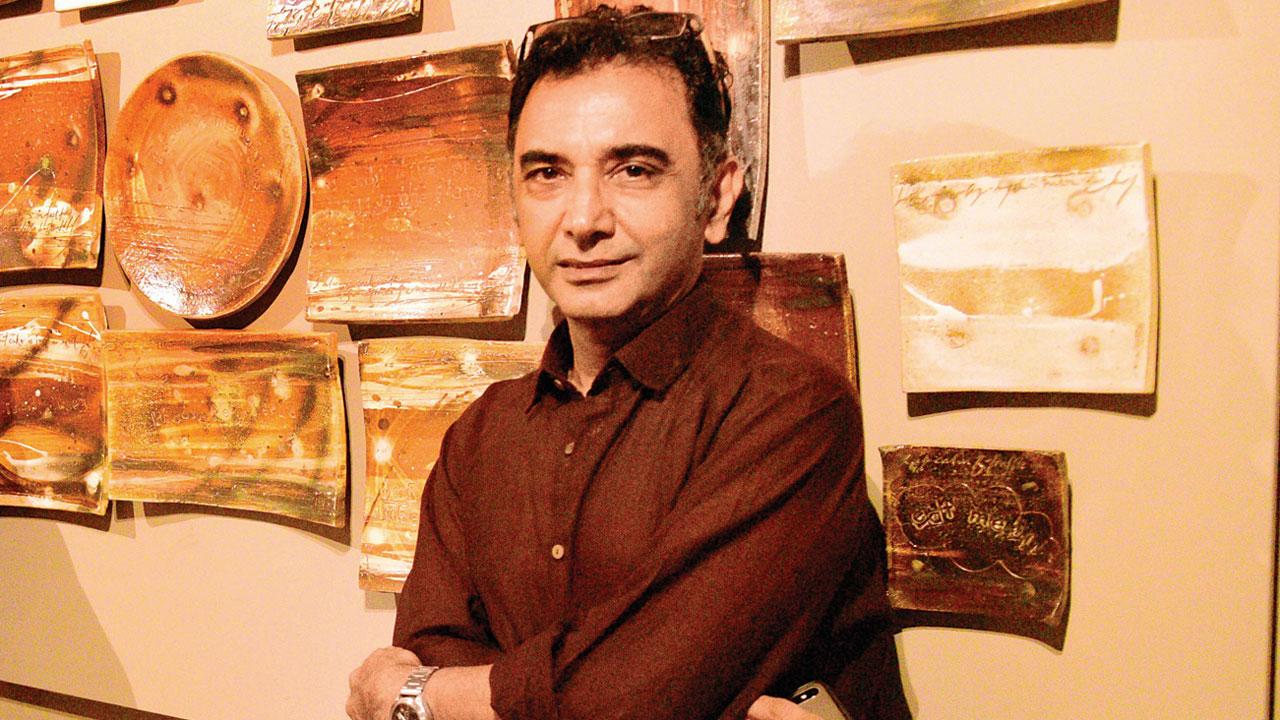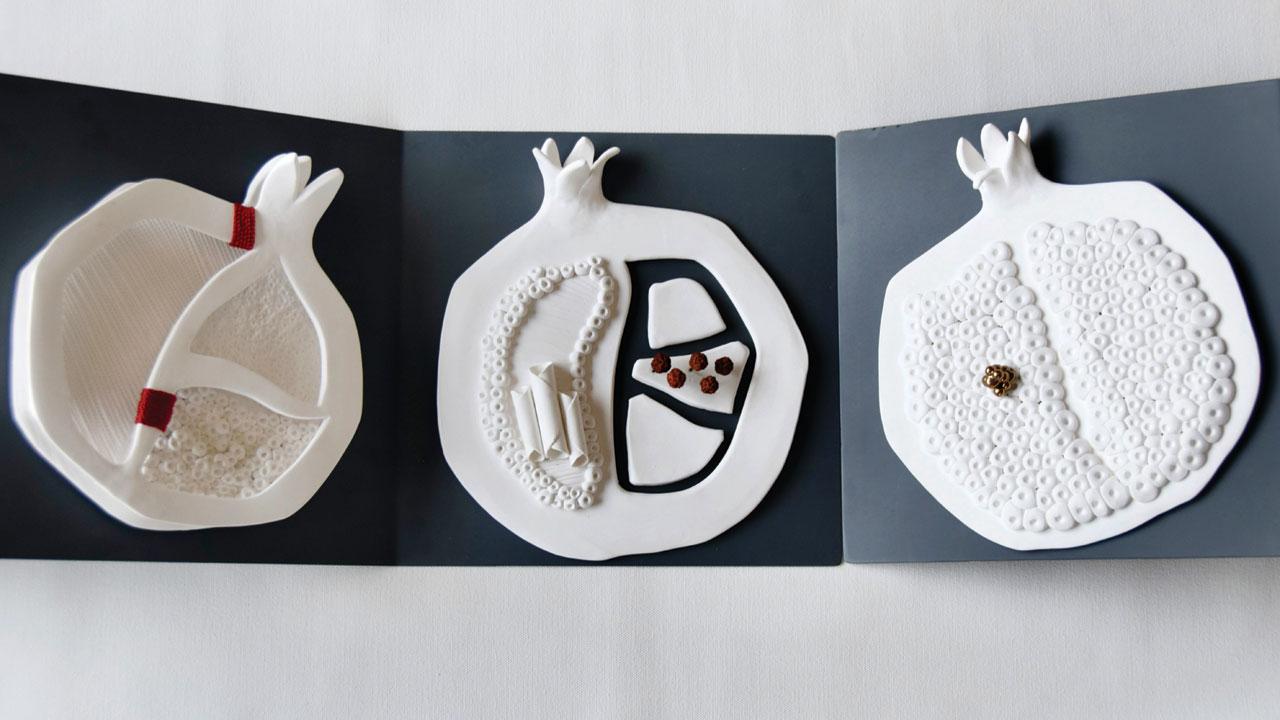Artists Adil Writer and Shayonti Salvi have come together to co-curate a unique tableware exhibition that blurs the boundaries between food and art

Shayonti Salvi’s Merging Cultures brings together Greek archaeological pottery forms with Japanese Shibori work on it, made on Chinese porcelain
Ceramic artist, painter and architect Adil Writer shares the most important information with us right at the end of our walk-through of his new exhibition, Table Manners 2: “I love to cook, and I don’t follow any rules. If I hadn’t been an architect, I would have been a chef or in the catering line.” Back in the day, he says, there wasn’t a “market for male chefs,” and so, his dad insisted that he pursue engineering. The rest, of course, is history. Writer is doing many different things today, including creating unique ceramic and earthenware, some of which you can also eat out of. A curated set of this tableware is on display on a tabletop at the new art show in Gallery Art and Soul, Worli.
ADVERTISEMENT
Most of the glazed pieces were made at the ceramic bottega of his friend Mirta Morigi in Faenza, Italy. He had hidden them away in his Auroville home for two years, until Tarana Khubchandani, the director of the gallery, added a new coat of paint on the white walls of her gallery. He tells us how Khubchandani has been convincing him to do Part 2 of Table Manners-1 that he had curated with Rakhee Kane at Gallery Square Circle in Auroville, for nearly a decade. His stipulation to bring the show here was that he wanted dark walls, so that the starkness of his table—the naked kadappa tabletop on Siporex blocks, with a bulb dangling from above—would show. She got him to settle for grey, he jokes.

There’s a large colourful plate at the centre of Writer’s table. The only non-handmade item here is a kaffir lime, which he says, is from his garden; it’s kept on the plate with a pair of non-perishable bananas. He scrapes the zest of the yellow lime and a citrusy whiff fills the space between us. Joining us is the co-curator of the show, interior designer and sculptor Shayonti Salvi.
It was around two years ago that work for the exhibition began. The duo invited over 60 artists to send in proposals for table settings and wall murals. “Adil’s brief was clear, and we expanded on that. It had to be food-related functional art,” says Shayonti. So, no hairy-fairy concepts and absolutely no metaphors, Writer shares. “Even the murals on the wall had to be derived from that idea of functional tableware,” she says. Seventeen artists, including Writer and Shayonti, were to showcase their work in March 2020. The show has since then been postponed twice due to COVID-19 lockdowns, and finally opened in September.
“It’s all kala,” Writer says, as we move from table after table—each showcasing the work of a singular artist. He is aware that tableware has often been relegated to crafts in India. But in Sanskrit, there’s no difference between the arts and crafts, he says. “The one who practises kala is called the kalakar.”

Aarti Manik’s Bombay Tiffin Service 2020, includes a stack of serving vessels that are inspired from the concept of a tiffin
Shayonti adds, “The idea of the show was to bridge the gap [between what is considered art and craft]. We have high-level artists in this show, participating alongside studio potters who work individually, and production houses. We didn’t want to make any distinction.” Ultimately, she says, it all boils down to skill.
One of the more interesting works on display is Aarti Manik’s minimalistic, yet eye-catching tableware, the Bombay Tiffin Service 2020. The 23 piece-set includes a stack of serving vessels that are inspired from the concept of a tiffin, which Manik, a teacher at Golden Bridge Pottery, introduces to a formal dining setting. All her pieces are wheel-thrown stoneware, fired in an Angama kiln for over 90 hours.
Among the murals, there’s Shweta Mansingka’s The Pomegranate 2020, which is porcelain with gold lustre on a stainless-steel frame. She chose the pomegranate as her form “because it inspires me with its symbolism of prosperity, abundance and constantly evolving life cycle”. “Food is not only something that provides nutrition to nourish our body, but also something that nurtures our mind and thoughts.
The ripeness of a fruit is not an end, rather it’s the mature belly nurturing fresh seeds as potential to perpetuate life. A fruit in all its maturity embodies the very womb of creation,” she shares in her note. The other contributing artists and studios include Amrita Dhawan, Devyani Smith, Ranjita Bora, Sabrina Srinivas, Saraswati, Anjani Khanna, Anoushka Iris, Panthini Thaker, Rahul Kumar, Vinod Daroz, Neha Kudchadkar and Atelier Lālmitti.

Adil Writer, who along with Salvi has curated Table Manners-2 at the Gallery Art and Soul, Worli, is showcasing tableware that he made at the ceramic bottega of his friend Mirta Morigi in Faenza, Italy, and a mural, Food is Memories. Pics/Pradeep Dhivar
Shayonti’s mural, Koi Fish, 2019, comprises 35 cheese platters, all gas-fired stoneware and porcelain with sgraffito on glaze, which when on display on the grey wall, come together to create a pattern of a koi fish. “My husband [Kunaal Roy Kapur] and I enjoy scuba-diving in a big way, and a lot of my sculpting work is based on underwater and oceanic themes. For this reason, the Koi fish keeps coming up in my work. I also love cheese. I could live on it, and right now, with so many people making cheese in India, it just feels like the most joyous time [for me],” shares Shayonti, of what inspired her mural. When working on art that delves into food, she says an artist can’t think of one without the other. It’s a simultaneous process. Her tableware, Merging Cultures, for instance, is inspired by a multitude of ideas.
The 40 piece set is wheel and hand-built, glazed porcelain. “I am part Sindhi, part Maharashtrian, and my husband is part Punjabi, part Jewish, so our kids are a mix of everything,” she shares. Merging Cultures brings together Greek archaeological pottery forms with Japanese Shibori work on it, made on Chinese porcelain. “The whole idea is to dissipate these geographical boundaries, which we have slotted ourselves into. That’s what happens when you sit down and eat food. You just enjoy the meal regardless of whom you share it with,” she says.
What interests Writer most is how chefs relate to such work. His tableware set, Made in Italy, has reds, blacks, metallic greys and a striking bright blue. “It’s Mirta’s colour palette, but layered very differently by me. I went out on a limb glazing these without testing them, but it’s turned out extremely satisfying. Like I say, God is in the experiments,” says Writer, whose mural, Food is Memories, which includes functional tableware (soda-fired and wood-fired stoneware), made at the Mandala Pottery studio in Auroville is also displayed at the exhibition.

Shweta Mansingka’s mural The Pomegranate 2020, which is porcelain with gold lustre on a stainless-steel frame. She chose the pomegranate as her form “because it inspires me with its symbolism of prosperity, abundance and constantly evolving life cycle”
Incidentally, blue is not favoured when it comes to tableware—it has been found to be the only appetite suppressant in the colour spectrum. But in the hands of his chef friend Jay Adams at Coromandel Café, Puducherry, who plated purple pasta on a blue plate, made by him, the food could have never looked more delicious and appetising. The point of the show, he says, was not just to make unique tableware, but to turn ideas about art and craft on its head. “You can serve food in them, as they are completely usable. You can also hang them on your wall, as they are displayable. It all depends on what you want to do with them,” adds Writer of the pieces that are all up for sale.
To Visit: Gallery Art and Soul, Worli, 10 AM-6 PM, till November 6
 Subscribe today by clicking the link and stay updated with the latest news!" Click here!
Subscribe today by clicking the link and stay updated with the latest news!" Click here!







